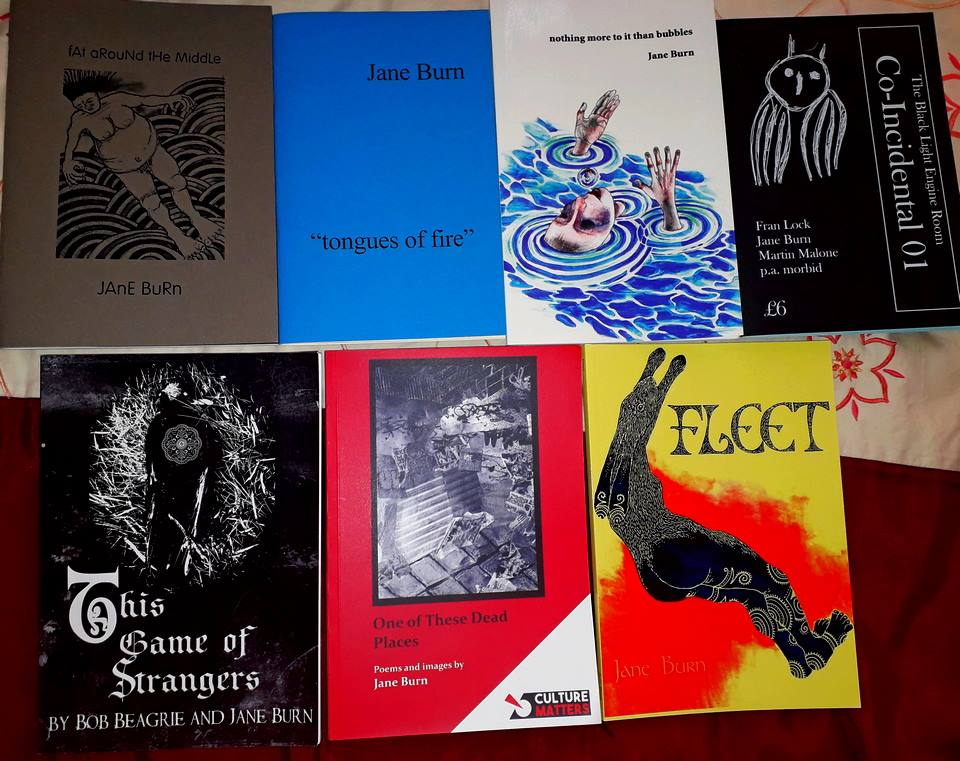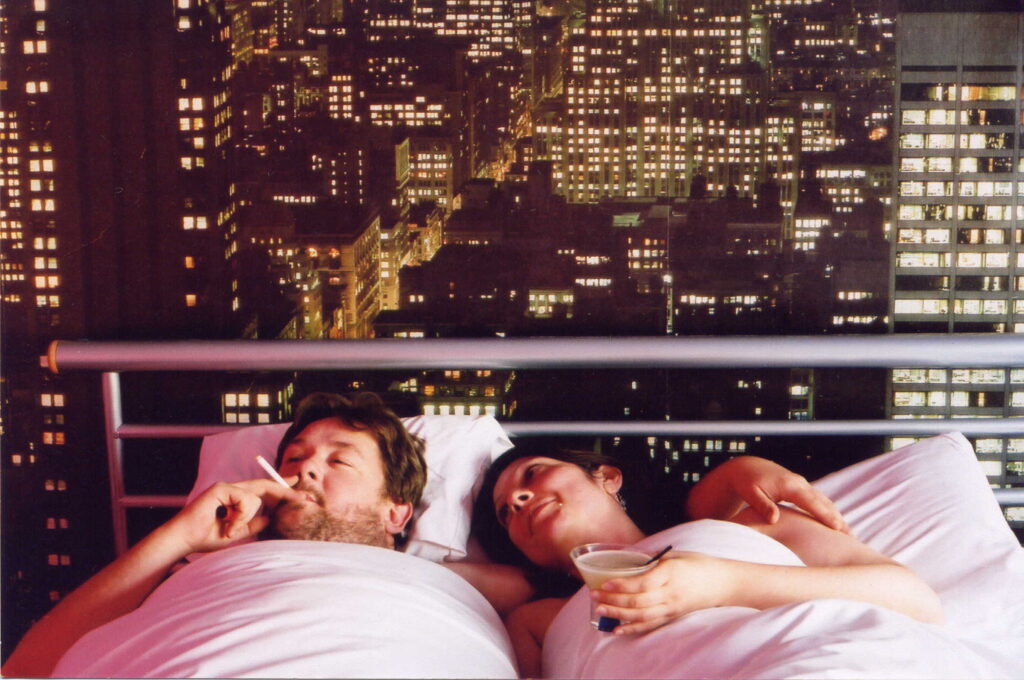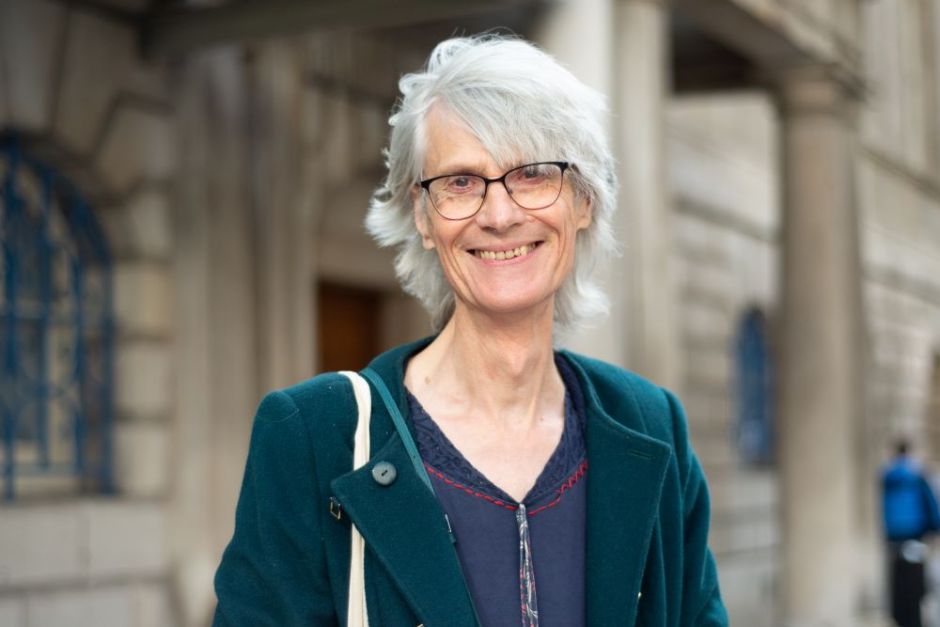
JANE BURN – POETRY AS HARD GRAFT, INSPIRATION, REACTION OR EXPERIMENT?
I interviewed poet & artist Jane Burn who won the Michael Marks Environmental Poet of the Year 2023-24 with A Thousand Miles from the Sea.


I interviewed Liza Frank folklorist, photographer and former stage manager with two books to her name Everyday Folklore, an almanac for the ritual year and My Celebrity Boyfriend. Liza tells her story – how she’s worked in various roles in theatres including the RSC and the Young Vic, answered questions with her photography, found out what it was like to live by the rules of folklore for a whole year, and how she’s realised that folklore can be a quirky alternative for solving problems.
Leslie: Tell us about how you came to write your book Everyday Folklore, an almanac for the ritual year and the ways you include folklore, ritual and tradition into your everyday life.
Liza: Even if we think we don’t “do folklore”, all of us participate in it in one way or another. Folklore is not just about avoiding walking under ladders, eating garlic to repel vampires, or muttering ‘red sky at night, shepherd’s delight’ at the end of the day. Essentially folklore is what we do and what we believe, traditions like blowing out candles on a birthday cake, celebrating a win by dancing the robot, or wearing black to a funeral. And every culture be it nationally, regionally, the local bowling club, or even your own family will have its own set of rules, regulations and rituals: its own folklore. Take for example Shrove Tuesday in the UK, everyone has a different way of making pancakes, topping pancakes, eating pancakes, racing pancakes, or just ignoring pancakes altogether.
Everyday Folklore was the result of a year-long study of consciously incorporating folklore into my life every day by way of The Everyday Lore Project. Between 7 Jan 2020 and 6 Jan 2021, I followed the ritual year by participating in the folklore of the day, month or season, then publishing a blog every night documenting what I’d got up to. Despite the pandemic interrupting what should have been a very jolly year of fire festivals, pixie hunting and some rather odd annual competitions, recreating the ritual year at home with what I had to hand, made for an unexpectedly satisfying challenge. Everyday Folklore takes the idea a stage further by suggesting folkloric ideas for the reader to get involved in throughout the year. This could be anything from sacrificing whisky to the sea gods, to hiding messages in walnuts, to competing in shin-kicking competitions, to unlocking the mysteries of the weather by looking at the clouds.

I adopted a fair whack of the folklore I researched while completing the project and writing the book. One of my favourites is that now every year I make my Christmas pudding over Zoom with my friend Sarah. We aim for Stir Up Sunday (the last Sunday before Advent), the traditional date to make Christmas puddings, but last year we freestyled with Stir Up Tuesday, our tradition being less about the date and more about spending time together over pudding basins. I also now pay much more attention to the world around me. What the sky is doing (mares’ tails and mackerel scales make lofty ships to carry low sails), what the moon is doing (new moons are good for divinations), and what the hedgerows and cracks in the pavements are flowering with (good for remedies, salads and pies). And I’m also much more aware of how joyous paying attention can be, like looking forward to the yellow of daffodils and dandelions in spring, or the sloes and blackberries of autumn, counting the fogs in August to predict out how many snowfalls there’ll be in winter, even playing techno music to scare away spiders…
Leslie: In retrospect, what did you learn from working backstage as a stage manager in theatre and then later flipping the script and working for two Artistic Directors as their assistant?
Liza: Mostly having a good poker face! You know that old cliché of the swan being serene up top and desperately paddling beneath the surface? I would say that applies equally to stage management and being a personal assistant. When everything around you is going tits up, if you can present a bland, yet attentive face while working out what needs to be done, you’re winning.
I loved working in theatre. Backstage I got to travel round the UK and the world mucking about with props and plays. And as the assistant to Michael Boyd at the Royal Shakespeare Company and David Lan at the Young Vic, I got to understand more about theatre holistically. It did feel at times like I was poacher turned game keeper, but working both sides gave me a better appreciation of everyone and everything involved.

Leslie: How did you go from being a stage manager to being a published photographer with My Celebrity Boyfriend? What did you discover about yourself during the process?
Liza: Luck really, and a lot of hard work and favours. When I left stage management in my late 20s, I had no idea what I wanted to do. So I chose to study two subjects that interested me, photography and British Sign Language. Regrettably, I was terrible at BSL for many reasons (I had thought to train as a BSL interpreter for theatre) and gave it up in my second year. But what I lacked in technical skill as a photography student, I made up for in creativity. My Celebrity Boyfriend was originally my graduation exhibition piece – a collection of framed photographs of me and famous men. It had grown from a street art project where the men were all random and turned celebrity after a fellow student dared me to ask some of my ex-colleagues for a picture. Although I already knew many of my Boyfriends, there were a lot I didn’t, hence me calling in favours and promising many more in return for introductions (I’m sure there are some people’s bar tabs I’ll be paying until their retirement). But the biggest stroke of luck was working for a Boyfriend’s wife as a children’s shoe fitter (the things I could tell you about hammer toes), and through her talking about my graduation piece with friends, who then talked to their friends, I got a call from Bloomsbury asking me to come and see them. And a big box of photos and a cup of tea later, the book was commissioned. All in all, the project took about four years of meticulous planning and good fortune from inception to publication in 2007.
Executing the project was a very steep learning curve. All the Boyfriends had full creative control as to how we would pose, so I had to be technically ready for everything in terms of equipment and emotionally ready to leave all my inhibitions and natural shyness behind in order to fulfil the brief. Which is easier said than done when you’re on a barge recreating the 1920’s black and white film, L’Atalante, or you have your thigh pressed up against the guy you had a massive crush on at sixth form, or when you’re posing semi-naked in a bush in January with a very attractive actor. I think all the poker face training definitely helped!
Leslie: How did The Billy Ray? Project begin, grow and develop? What have you learned from it?
Liza: The Billy Ray? Project started way before any photographs were ever taken, before I’d even really started my theatre career. I was filling in for the Deputy Wardrobe Mistress at The Orange Tree Theatre in Richmond, which meant I did all the washing and ironing. The show in question was very white shirt heavy, so it would take me most of the morning to get everything back on hangers. This was in the days of cassette tape Walkmans, and the cassette I was playing to death while ironing was the Pulp Fiction soundtrack. Although all the tracks are absolute bangers, Son of a Preacher Man sung by Dusty Springfield was the one that got stuck in my head. I don’t know what it is about sons of preacher men and theatre, but as my career progressed, I kept working with them. And because of this song, I always wondered what it was they could teach me.

At this point, however, my creativity was all about making and mending props and costumes, so it was always just a thought. But when I started playing around with photography, I decided to satisfy my curiosity. So armed with a camera and a Dictaphone, I started interviewing Billy Rays and asking them to teach me something, as the only one who could ever teach me, was the son of a preacher man. One of my more memorable encounters was discovering the guy driving my bus across the North Island of New Zealand was a son of a preacher man. I ended up conducting his interview and learning the haka sitting in the footwell of his bus as he drove us across the Coromandel Peninsula. Other honourable mentions include learning how to solve a cryptic crossword clue in the middle of an after-party in the suburbs of Perth, having a weird synesthetic experience learning how to fire a gun, and learning how to wiggle my ears in a friend of a friend’s back garden (ear wiggling apparently takes multiple years to perfect). Although the project has mostly wound down now, whenever I come across a Billy Ray, I still have that nagging desire to find out what they know and what they feel they could teach me.
Leslie: Tell us about the Folklore Agony Aunt, why have you adopted this persona? How did it come about?
Liza: It’s not uncommon for people to turn their noses up at the thought of folklore as being anything other than phooey. And to be fair, wrapping your lover’s thigh in a ribbon of skin flayed from a 9 day old buried corpse in order to keep them faithful doesn’t sound exactly practical. But I find it fascinating what people believe/believed would solve their problems. So the Folklore Agony Aunt was born as I wanted to explore how one might solve a dilemma using folklore. So far I’ve tackled questions such as what to do with a boils (ducks and dogs), how to mend a broken heart (viper’s bugloss and powdered earthworms), and how to persuade pesky neighbours not to pester (salt, dill and nettles).
And it’s not always straightforward answering someone’s problem. A lot of the time, I have to think laterally to make my answer as holistic as possible because it’s never really just one thing the questioner is asking. I also try to be as respectful to the beliefs of others, but sometimes some of the folklore I’ve found is just bananas. Fascinating, but bananas. Like who decided the remedy for a stye involves pointing nine gooseberry bush thorns at your eye three times having thrown the tenth thorn away? (I mean, everyone knows you rub a gold ring on a stye to get rid.) While we may not believe that taking ferret poo will cure a cough or wearing a wasps nest as a hat will attract a lover, sometimes looking at a problem from a different perspective can be the push we need to try something different. Not necessarily scraping moss off a dead man’s skull different, but not repeatedly bashing your head fly-like into the window pane expecting things to change.
Leslie: What have been your guiding lights? What experiences have shaped you – why them?
Liza: I have been wracking my brains about how to answer this question. My love of folklore came from reading authors such as Joan Aiken, Lloyd Alexander and Eva Ibbotson as a child. Using folklore in storytelling – not just the traditional fairy tale type folklore – provides such possibility. If we’re talking photography, I remain in awe of photographers such as Dorothea Lange, Lee Miller and Walker Evans. If I could capture a thimble’s worth of their talent, I would be a very happy women. But when it comes to writing, then it’s always my dad who’s the voice inside my head. He was a film critic for many years and a prolific author and he always used to say, ‘They don’t want it perfect, they want it Thursday’.
Next week I interview fashion rebel and animal rights activist Bel Jacobs.
ABOUT LESLIE TATE’S BOOKS:

I interviewed poet & artist Jane Burn who won the Michael Marks Environmental Poet of the Year 2023-24 with A Thousand Miles from the Sea.

I interviewed ex-broadcaster and poet Polly Oliver about oral and visual poetry, her compositional methods, and learning the Welsh language. Polly says, “I absolutely love

I interviewed Jo Howell who says about herself: “I’ve been a professional photographic artist since I left Uni in 2009. I am a cyanotype specialist.


Poet Tracey Rhys, writer of Teaching a Bird to Sing and winner of the Poetry Archive’s video competition reviews Ways To Be Equally Human. Tracey,
| Cookie | Duration | Description |
|---|---|---|
| cookielawinfo-checkbox-analytics | 11 months | This cookie is set by GDPR Cookie Consent plugin. The cookie is used to store the user consent for the cookies in the category "Analytics". |
| cookielawinfo-checkbox-functional | 11 months | The cookie is set by GDPR cookie consent to record the user consent for the cookies in the category "Functional". |
| cookielawinfo-checkbox-necessary | 11 months | This cookie is set by GDPR Cookie Consent plugin. The cookies is used to store the user consent for the cookies in the category "Necessary". |
| cookielawinfo-checkbox-others | 11 months | This cookie is set by GDPR Cookie Consent plugin. The cookie is used to store the user consent for the cookies in the category "Other. |
| cookielawinfo-checkbox-performance | 11 months | This cookie is set by GDPR Cookie Consent plugin. The cookie is used to store the user consent for the cookies in the category "Performance". |
| viewed_cookie_policy | 11 months | The cookie is set by the GDPR Cookie Consent plugin and is used to store whether or not user has consented to the use of cookies. It does not store any personal data. |
2 responses
Hi Leslie, this is such an interesting post. The UK offers so many fascinating opportunities for creatives. I love reading about folklore.
Thanks, Robbie. Yes, Liza is so interesting in so many ways!